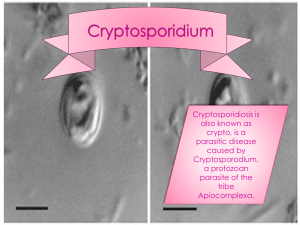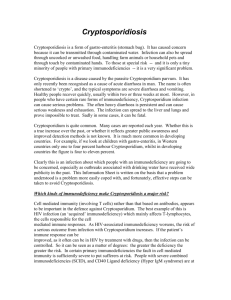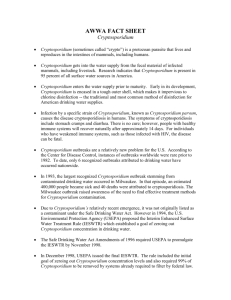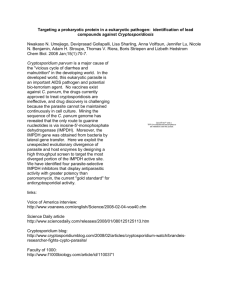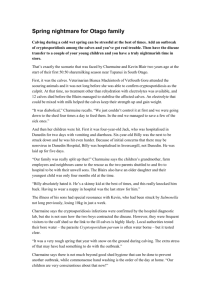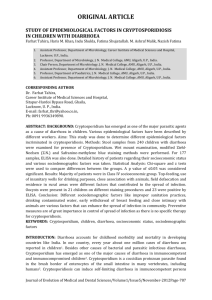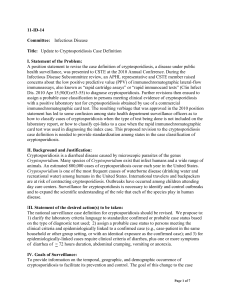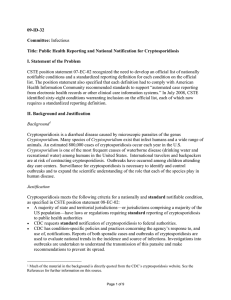Cryptosporidiosis, caused by the ubiquitous protozoan parasites
advertisement
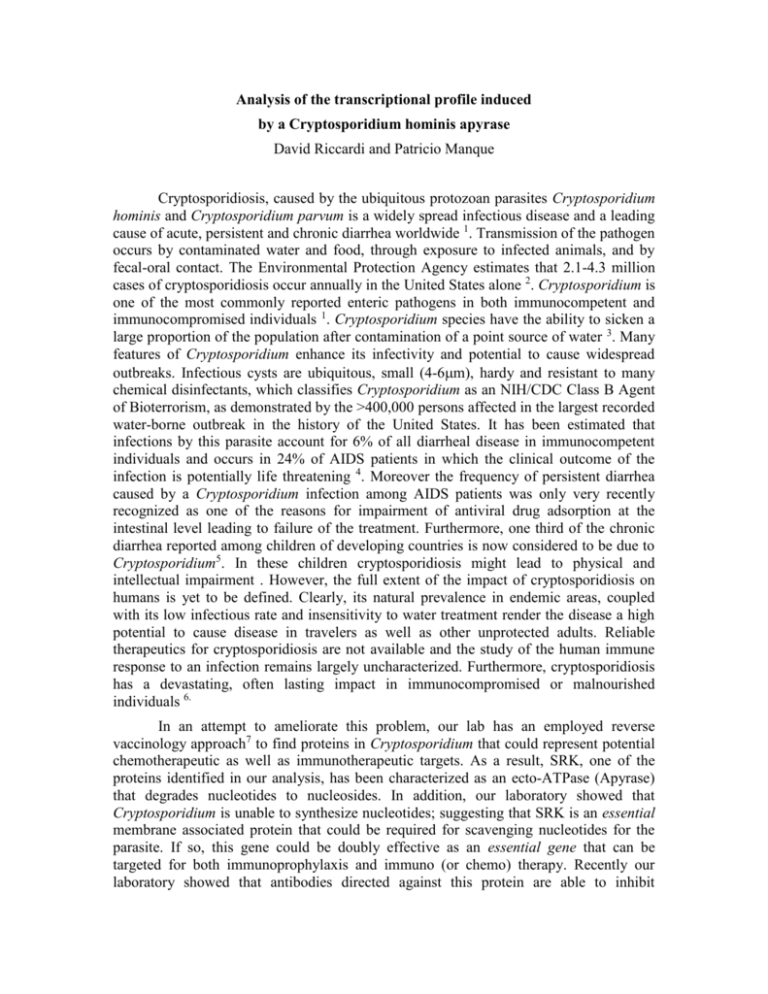
Analysis of the transcriptional profile induced by a Cryptosporidium hominis apyrase David Riccardi and Patricio Manque Cryptosporidiosis, caused by the ubiquitous protozoan parasites Cryptosporidium hominis and Cryptosporidium parvum is a widely spread infectious disease and a leading cause of acute, persistent and chronic diarrhea worldwide 1. Transmission of the pathogen occurs by contaminated water and food, through exposure to infected animals, and by fecal-oral contact. The Environmental Protection Agency estimates that 2.1-4.3 million cases of cryptosporidiosis occur annually in the United States alone 2. Cryptosporidium is one of the most commonly reported enteric pathogens in both immunocompetent and immunocompromised individuals 1. Cryptosporidium species have the ability to sicken a large proportion of the population after contamination of a point source of water 3. Many features of Cryptosporidium enhance its infectivity and potential to cause widespread outbreaks. Infectious cysts are ubiquitous, small (4-6m), hardy and resistant to many chemical disinfectants, which classifies Cryptosporidium as an NIH/CDC Class B Agent of Bioterrorism, as demonstrated by the >400,000 persons affected in the largest recorded water-borne outbreak in the history of the United States. It has been estimated that infections by this parasite account for 6% of all diarrheal disease in immunocompetent individuals and occurs in 24% of AIDS patients in which the clinical outcome of the infection is potentially life threatening 4. Moreover the frequency of persistent diarrhea caused by a Cryptosporidium infection among AIDS patients was only very recently recognized as one of the reasons for impairment of antiviral drug adsorption at the intestinal level leading to failure of the treatment. Furthermore, one third of the chronic diarrhea reported among children of developing countries is now considered to be due to Cryptosporidium5. In these children cryptosporidiosis might lead to physical and intellectual impairment . However, the full extent of the impact of cryptosporidiosis on humans is yet to be defined. Clearly, its natural prevalence in endemic areas, coupled with its low infectious rate and insensitivity to water treatment render the disease a high potential to cause disease in travelers as well as other unprotected adults. Reliable therapeutics for cryptosporidiosis are not available and the study of the human immune response to an infection remains largely uncharacterized. Furthermore, cryptosporidiosis has a devastating, often lasting impact in immunocompromised or malnourished individuals 6. In an attempt to ameliorate this problem, our lab has an employed reverse vaccinology approach7 to find proteins in Cryptosporidium that could represent potential chemotherapeutic as well as immunotherapeutic targets. As a result, SRK, one of the proteins identified in our analysis, has been characterized as an ecto-ATPase (Apyrase) that degrades nucleotides to nucleosides. In addition, our laboratory showed that Cryptosporidium is unable to synthesize nucleotides; suggesting that SRK is an essential membrane associated protein that could be required for scavenging nucleotides for the parasite. If so, this gene could be doubly effective as an essential gene that can be targeted for both immunoprophylaxis and immuno (or chemo) therapy. Recently our laboratory showed that antibodies directed against this protein are able to inhibit Cryptosporidium infection in human HCT-8 cells. Moreover, immunolocalization experiments suggested that the protein is located in the apical complex, opening the possibility that this protein may be exported to the host cell playing a central role in the survival of the parasite. Thus, SRK is truly a novel target with high potential as a vaccinogen for Cryptosporidium. Currently the goal of our lab is focused in characterize the role of SRK (Apyrase) in the interaction of Cryptosporidium with the host cell as well as its role as a potential as chemo/immunotherapeutic target. Thus, my project will characterize the transcriptional changes induced by SRK in HCT-8 cells. Methods Effect of SRK in HCT-8 cells. Untreated and Apyrase treated HCT-8 cells will be washed in PBS and total RNA extracted with the RNeasy Mini Kit (QIAGEN Inc, Valencia, CA) according to the manufacturer protocol. RNA will be extracted after 1, 6, and 24 of incubation. Target preparation and microarray hybridization. Labeling of target RNA and hybridization will be performed according to the Affymetrix manual for array processing. Briefly, double-stranded cDNA will be synthesized directly from total RNA using Superscript Choice system (Invitrogen Life Technologies). Biotin-labeled-cRNA will be then synthesized with the BioArray High Yield RNA transcript labeling kit (Enzo Biochem, New York, NY). After purification with RNeasy columns (Qiagen), fragmented cRNA will be hybridized to an Human U33 array (Affymetrix), and the chips will be washed and stained with streptavidine-phy-coerythrin using a fluidics station. Finally, the arrays will be scanned at high resolution using a GeneArray scanner (Agilent Technologies). Identification of differentially expressed genes (DEG) during the infection Image analysis Images resulting from the scanning of each hybridized GeneChip will be processed using MAS 5.0 software, and the resulting CEL files will be analyzed using RMA method (Irizarry et al., 2003), using the Affy package (Gautier et al., 2004), included in Bioconductor software (Gentleman et al., 2004). All hybridizations will be analyzed in one batch to maximize their positive correlation. Statistical determination of differential expressed genes (DEG) The data resulting from the RMA analysis will be submitted to the SAM method (Tusher et al., 2001), by a two class unpaired test, with 2,000 permutations. Using false discovery rate and fold change thresholds of 0.05 and 1.5, respectively, providing us with the list DEG. Verification by Real time PCR Genes that will be identified as differentially expressed during the infection in our microarray analysis will be verified by real time PCR using TaqMan TM technology. In brief, primers and probes specific for selected differentially expressed genes will be designed using Primer Express® version 2.0 (ABI). For each target, forward and reverse primers and an internal probe will be synthesized. Probes are synthesized with 5’ end linked FAM (6-carboxyfluoresceine) and 3’ end fluorescent TAMRA (6carboxytetramethylrhodamine) dyes. Amplification and analysis will be performed in our ABI7900HT instrument. ‘No reverse transcriptase’ will be performed to assess DNA contamination. Results We expect to identify genes and pathways that are modulated by the SRK protein. These results will provide essential insight into the mechanism of which SRK promote intracellular replication of cryptosporidium. However, it is possible that our results will reveal that SRK does not significantly affect gene expression in human HCT-8 cells. These results would just that SRK is not transported in the host cell and plays some other role in promoting cryptosporidium replication. Timeline We expect to finish the collection of gene expression data by the end of the summer and to analyze the data over the school year. Works Cited 1. Goodgame R. W. (1996) Understanding intestinal spore-forming protozoa: cryptosporidia, microsporidia, isospora, and cyclospora. Ann. Intern. Med. 124, 429-441. 2. EPA office of water. Cryptosporidium spp. systematics and waterborne challenges in public health. Summary Report 1999. 2002. Ref Type: Report. 3. MacKenzie W. R., Schell W. L., Blair K. A., Addiss D. G., Peterson D. E., Hoxie N. J., et al. (1995) Massive outbreak of waterborne cryptosporidium infection in Milwaukee, Wisconsin: recurrence of illness and risk of secondary transmission. Clin. Infect. Dis. 21, 57-62. 4. Current W. L., Garcia L. S. (1991) Cryptosporidiosis. Clin. Lab. Med. 11, 873897. 5. Guerrant R. L. (1997) Cryptosporidiosis: an emerging, highly infectious threat. Emerg. Infect. Dis. 3, 51-57. 6. Kosek M., Alcantara C., Lima A. A. & Guerrant R. L. (2001) Cryptosporidiosis: an update. Lancet Infect. Dis. 1, 262-269. 7. Wack, A., and Rappuoli, R. (2005). Vaccinology at the beginning of the 21st century. Current Opinion in Immunology 17, 411-418.

